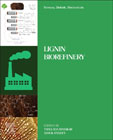
Biomass, Biofuels, Biochemicals: Lignin Biorefinery
Bhaskar, Thallada
Pandey, Ashok
With the increasing concerns over greenhouse gas emissions and climate changes, the world is moving towards the utilisation of renewable energy resources. Lignin, a by-product from pulp and paper industry and ethanol manufacturers, is a storehouse of high value chemicals. These are now produced from a non-renewable fossil resource called crude oil after several steps of refining and functionalization. If lignin is used to obtain the same chemicals, twin benefit from economic and environment perspective is obtained. Lignin Biorefinery discusses scientific and technical information relating to the structure and physico-chemical characteristics of lignin. The lignin obtained in various 2G ethanol plants across the globe and also pulp and paper industries are quite different. Due to lack of understanding of structural information along with the technologies/processes to be adopted for production of high value chemicals, the material is being utilized for low value applications including energy. The book covers the different processes (biological, thermal and catalytic routes) that are available for lignin conversion into specialty chemicals or fuels will be delved upon in detail with references and links to the detailed along with literature available till date. The structure activity relationships and the optimised process parameters help in establishing the feasible size of the commercial plant in a centralised or decentralised model. In addition, the advantages and limitations of different technologies are also discussed by considering the local energy/chemicals/biopolymers/drug intermediates/activated carbons/speciality carbons etc., demand, government policies, environmental impacts, and education in bioenergy. Provides information on the most advanced and innovative processes for lignin conversionCovers information on biochemical and thermo-chemical processes for lignin valorisationProvides information on lignin chemistry and its conversion into high value chemicals and fuelsA book designed as a text book, not merely a collection of research articles - Useful as a text book for graduate students and reference book for researchers INDICE: I General 1. Lignin: A versatile polymer a. Availability of lignin b. Types of lignin 2. Chemistry of lignin from pulp and paper industry 3. Chemistry of lignin from ethanol industry 4. Lignin from other sources II Lignin Biorefineries/Lignin Valorization 5. Biological lignin decomposition 6. Enzymatic degradation of selective bonds in lignin 7. Aerobic and anaerobic pathways for lignin degradation 8. Systems biology approaches for lignin conversion 9. One-pot reactions with lignin model compounds 10. Upgradation of lignin model compounds in fixed bed reactor 11. Selective production of high value chemicals and specialty chemicals from lignin and its model compounds 12. Functional carbons for drug delivery applications 13. Specialty carbons for energy applications 14. Electrochemical applications for activated carbons 15. Lignin resource as a resource for protein production 16. Aviation fuels and high value petrochemicals from lignin 17. Solid catalysts: Opportunity for lignin valorization 18. Homogeneous catalysis for functional transformations of lignin III Associated studies 19. Techno-economic calculations of case studies with respect to lignin conversion (biochemical route and thermochemical route) 20. Life-Cycle Analysis of present day lignin conversion processes 21. Carbon and water footprint calculations along with energy and exergy balances of case studies with respect to lignin conversion (biochemical route and thermochemical route) 22. Supply chain optimization of lignin and its derived products (well to wheel)
- ISBN: 978-0-12-820294-4
- Editorial: Elsevier
- Encuadernacion: Rústica
- Páginas: 512
- Fecha Publicación: 01/10/2020
- Nº Volúmenes: 1
- Idioma: Inglés
